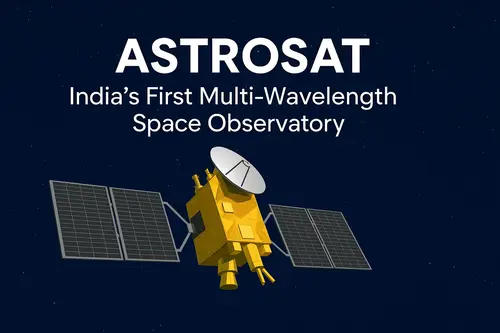
Introduction
India launched AstroSat in 2015 with the intention of a 5-year life cycle, but a decade later, the remarkable space observatory is still probing the secrets of the universe, far beyond its expected lifetime. As India’s first dedicated multi-wavelength space observatory, AstroSat is a milestone accomplishment for the Indian Space Research Organisation (ISRO), which shows the increasing capability of the country in cutting-edge space science.
Unlike most satellites, which study a distinct part of the electromagnetic spectrum, AstroSat has a unique capability to study a combination of celestial objects in the X-ray, ultraviolet, and optical wavelengths at the same time. This unique capability makes it a ‘cosmic eye’, and like the astounding vision in the future, it is like the mythical Hubble Space Telescope and the James Webb Space Telescope (JWST).
Throughout the span of a decade, AstroSat has made great contributions to global astronomy as it studied black holes, neutron stars, high energy X-ray binaries to even observing the eruption of novae in Andromeda, which is 2.5 million lightyears away. All of this demonstrates its lasting importance to India, demonstrating that India’s local observatory can have prominence on the world stage of astral impact.
The Launch of AstroSat: PSLV-C30’s momentous flight
On September 28, 2015, AstroSat embarked on its space journey aboard ISRO’s reliable workhorse, the Polar Satellite Launch Vehicle (PSLV-C30) in its heaviest XL configuration. The rocket launched from Satish Dhawan Space Centre (SDSC), Sriharikota, carrying both AstroSat and six foreign co-passenger satellites Into low Earth orbit.
Weighing 320-tonne, 45 metres tall PSLV delivered AstroSat in a near-perfect orbit of ~650 km altitude and 6° inclination, marking ISRO’s 30th consecutive successful PSLV mission flight. The launch was a demonstration of high precision, showcasing the trustworthiness and multiplicity of satellite launch vehicle, which had been active in launching satellites for India and international customers.
In addition to its scientific relevance, the launch of AstroSat emphasised India’s growing role in the global space economy. By deploying foreign satellites with its premiere astronomy mission, ISRO undermined out the dual power of developing frontline science, and successfully launching commercial/satellite launches.
Characteristics & Scientific Instruments
AstroSat functions as a multi-wavelength spacecraft observatory, imaging the universe simultaneously across X-ray, ultraviolet, and optical wavelengths—a capability that few satellites currently possess. This allows scientists to study astrophysical events in greater detail, linking high-energy events with phenomena in ultraviolet and optical wavelengths.
AstroSat has five primary scientific payloads:
- Ultraviolet Imaging Telescope (UVIT): UVIT is able to make several high-resolution images in both the far and near ultraviolet range, particularly useful for studying hot young stars and star-forming regions.
- The Large Area X-ray Proportional Counter (LAXPC)– precisely measures X-ray emission and enables highly detailed studies of neutron stars, pulsars, and black holes.
- Soft X-ray Telescope (SXT): SXT is an imaging payload that will reveal black holes and supernova remnants in the soft X-ray band.
- Cadmium Zinc Telluride Imager (CZTI): CZTI enables hard X-ray imaging and polarization that will inform on extreme cosmic environments.
- Scanning Sky Monitor (SSM): SSM detects bright, transient X-ray sources, taking images of major cosmic events such as gamma-ray bursts.
The ability to observe multi-wavelength phenomena simultaneously is what sets AstroSat apart. Scientists will be able to combine information from X-ray, UV, and optical wavelengths to develop a complete understanding of hard-active phenomena that a single-band observatory typically cannot achieve.
Scientific Objectives
India launched AstroSat with clearly articulated goals, intending to enhance its capabilities in astrophysics.:
- The investigation of binary systems containing neutron stars and black holes, and the dynamics and energetics associated with them.
- Measuring and estimating the magnetic fields of neutron stars.
- Investigating star formation regions, both within the Milky Way and outside of it.
- Scientists detect transient high-energy events, such as gamma-ray bursts, to understand the most energetic phenomena in the universe.
- Running a limited ultraviolet deep field survey mapping parts of the sky known for star formation and early galactic activity.
AstroSat’s scientific goals were groundbreaking, as they provided the first major steps for India in developing space-based astronomy expertise and capacity, in complimentary data alongside other observatories, while developing indigenous capabilities.
Key Discoveries and Achievements
Almost ten years later, AstroSat has more than lived up to its promise, providing significant scientific contributions:
- Using UVIT, AstroSat observed far-ultraviolet emissions from novae in the Andromeda Galaxy, providing astronomers with the ability to study the binary star evolution and the accretion processes of white dwarfs.
- Provided important studies of black holes and x-ray binaries in the Milky Way, providing new observational insight into the behavior and dynamics of high-energy variability.
- Mapped star birth regions and contributed to understanding the cosmic ultraviolet background as a new aspect of their research of galaxies and their process of formation.
- AstroSat contributed to studies of galactic chemical enrichment, identifying how galaxies recycle and disperse elements.
- The mission has been a partnership where IUCAA, TIFR, IIA, RRI, and partnerships with Canada and the UK made major contributions.
- AstroSat continues to produce high-quality data long after its designed life of five years, underscoring ISRO’s extraordinary engineering success and the mission’s scientific value for the future.
Comparison with other telescopes
AstroSat vs Hubble
The Hubble Space Telescope has transformed astronomy since its launch in 1990, by providing unprecedented optical and ultraviolet views of the universe. Like Hubble, AstroSat can observe UV but also includes X-ray coverage that Hubble cannot.
Hubble can also achieve far greater resolution and scale than AstroSat can with its mirror and instruments; however, AstroSat is a significant milestone for Indian space science because it is cost-effective and fully indigenous.
AstroSat and James Webb Telescope (JWST)
The James Webb Space Telescope is designed to operate primarily in the infrared spectrum and was launched in 2021 to examine the earliest galaxies and exoplanet atmospheres. JWST offers approximately 100 times the sensitivity and resolution of AstroSat.
Nonetheless, almost six years earlier, AstroSat was launched as an entirely Indian mission, demonstrating independence in building a more advanced observatory. AstroSat was an India-led mission, while JWST was an international partnership between NASA, ESA, and CSA, representing a separate distinction in independent space science.
The Hubble and JWST telescopes are unquestioningly giants in astronomy and set the standard for observatories globally. Paradoxically, the National Aeronautics and Space Administration or NASA’s JWST and Hubble are expensive, but the significance of AstroSat comes from scientific productivity, cost efficient, and indigenous capacity; it is not merely a telescope. As India’s first leading capacity to engage in cutting edge observatories into space, India has a first step to lead in frontier space observatories to new missions.
Significance of AstroSat
AstroSat has successfully outlived its 5-year operational lifetime, which is a true demonstration of ISRO’s engineering capabilities. In addition to providing invaluable data to researchers across the world, AstroSat has made its data available in open-access archives, allowing researchers to pursue a diverse array of astrophysical applications.
Additionally, AstroSat shows that India can be a serious contributor to space science. In essence, AstroSat has demonstrated that frontier science could be achieved at a fraction of the cost of equal missions elsewhere. Furthermore, AstroSat has laid the groundwork for future Indian observatories in the X-ray, UV, & infrared domains. This future-facing approach will ensure that India has an active presence in space astronomy.
Conclusion
Although AstroSat is not as massive or sensitive as Hubble or JWST, it holds significance for India in a historical sense. It demonstrates that India can independently create and operate globally competitive space observatories that can deliver significant scientific results, with AstroSat observing everything from nova eruptions in Andromeda to X-ray binaries in our own galaxy. Furthermore, AstroSat represents India’s spirit of innovation, self-reliance, and curiosity about the cosmos. After nearly ten years, it continues to be a bright “cosmic eye” and a source of inspiration for future missions, firmly placing India on the world astronomy map.
FAQ’s
AstroSat is the first dedicated multi-wavelength space observatory for India, launched by ISRO in 2015, to conduct investigations of the universe in bands of X-ray, ultraviolet, and optical.
AstroSat, was designed to execute a mission of 5 years. However, it has been functional for nearly a decade, and its operational status still provides significant scientific data.
The objectives of AstroSat include the studying of binary systems with neutron stars and black holes, star formation regions, high energy transient events, as well as ultraviolet deep field surveys.
AstroSat is a homegrown mission, budget-friendly, and multi-wavelength (UV + X-ray + optical). Hubble operates in the optical and UV, while JWST’s emphasis is IR, and is much more sensitive.
AstroSat has observed nova explosions in the Andromeda Galaxy, researched black holes and X-ray binaries, and mapped regions of star formation, by contributing to the global astrophysical community.

